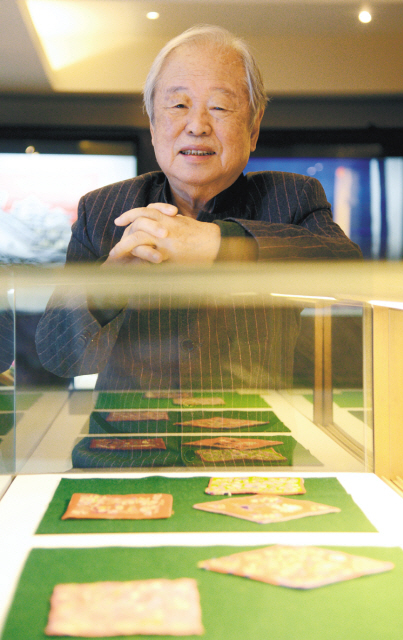Stitching beauty of Korean embroidery
The Museum of Korean Embroidery showcases much neglected craft, promoting Korean beauty abroad
By Lee Woo-youngPublished : Nov. 20, 2012 - 19:52

Following is part of a series exploring unique museums, collections and the passionate collectors behind them. ― Ed.
In the conservative Confucian society of Joseon, use of vibrant colors was restrained as they were thought to carry sexual connotations. As a result, the subtle use of color dominates many artifacts of Joseon as shown in white porcelain and clothes.
The only place that was free from the Confucian principle, however, was in Korean women’s boudoir culture, according to Huh Dong-hwa, director of the Museum of Korean Embroidery, which houses items created for the women’s private rooms ― ranging from embroidery, wrapping clothes, costumes to folding screens and pouches.
“The Korean women’s boudoir culture was isolated from the society and the isolation gave them freedom in using colors. And our museum is the only place which has kept traditional colors of Korea,” said Huh during an interview with The Korea Herald last week.
The embroidery and bojagi, or wrapping cloth, boast broad color palettes from red, purple, yellow and green to grey and dark blue, all in beautiful harmony with each other.
In the conservative Confucian society of Joseon, use of vibrant colors was restrained as they were thought to carry sexual connotations. As a result, the subtle use of color dominates many artifacts of Joseon as shown in white porcelain and clothes.
The only place that was free from the Confucian principle, however, was in Korean women’s boudoir culture, according to Huh Dong-hwa, director of the Museum of Korean Embroidery, which houses items created for the women’s private rooms ― ranging from embroidery, wrapping clothes, costumes to folding screens and pouches.
“The Korean women’s boudoir culture was isolated from the society and the isolation gave them freedom in using colors. And our museum is the only place which has kept traditional colors of Korea,” said Huh during an interview with The Korea Herald last week.
The embroidery and bojagi, or wrapping cloth, boast broad color palettes from red, purple, yellow and green to grey and dark blue, all in beautiful harmony with each other.

Huh, 87, established the museum in 1976 with some 100 works as the fruit of Huh and his wife Park Young-sook’s numerous trips to antique art markets. He now has an archive of over 3,000 items that show the artistry of Korean women and their artistic imagination.
“It’s interesting to see what they imagined. For example, there are birds and fish getting along in a pond and birds that look like flowers on a flower tree,” Huh added.
Huh, who also makes collages inspired by the craftworks and embroidery of old Korean women, is holding an exhibition of his own works at Youngeun Museum of Contemporary Art in Gwangju, Gyeonggi Province, through Dec. 16.
He also sheds new light on neglected female craft.
“The compositions that form bojagi are round, square and triangular, which resemble contemporary abstract paintings,” said Huh.
Jogakbo is made with scraps of fabrics left over from making clothes and consists of forms that are shaped by the cuts and colors of fabrics. The different colors create a beautiful balance of colors and unity in the overall color tone. Jogakbo, commonly made by lower class people, later spread to the nobility.
“Jogakbo represents the life of Korean women,” said Huh. “The different pieces of fabrics are leftovers from those used to make their traditional wedding gown, birthday costume for their babies and official attire for their husbands.”
“If they were looking at a piece of jogakbo, it would be like watching a family photo,” said Huh.
The museum is holding a rare exhibition that compares Korean bojagi with bojagi from Japan ― the two cultures which still uses bojagi in modern life.
With two pieces of Japanese bojagi in Huh collection and other pieces on loan from a Japanese collector, Huh put together the exhibition that shows the contrasting styles of bojagi of Korea and Japan.
“Japanese bojagi is more like figurative art and Korean bojagi is non-figurative,” said Lee Hye-kyu, curator of the museum. Japanese bojagi features birds, people and landscapes just like a painting while Korean bojagi consists of abstract forms such as round, square and triangular shapes. The bojagi exhibition continues through Dec. 31 at the Museum of Korean Embroidery.
The bojagi exhibition also marks 100th exhibitions of the embroidery museum, which holds a special exhibition once a year in Korea and more exhibitions in foreign countries.
It showcased Korean patchworks, costumes and other boudoir objects in Madrid, Spain, last year to mark the 60th anniversary of Korea-Spain diplomatic relations. Huh has held about 50 exhibitions overseas, including the United States, England, France, Germany, Belgium, Italy, Australia, New Zealand and Japan.
About 80 percent of the visitors to the museum are foreigners who take the time to see an exhibition during their tours in Korea, according to the curator.
“We see more foreigners than Koreans and I hope Koreans also come often and appreciate their tradition and culture,” said Lee.
■ The Museum of Korean Embroidery
● Adress: 89-4, Nonhyeon-dong, Gangnam-gu, Seoul / (02) 515-5118.
● Hours: 10:00 a.m.-4:00 p.m. Closed on Saturdays and Sundays.
● Admission is free.
By Lee Woo-young (wylee@heraldcorp.com)


















